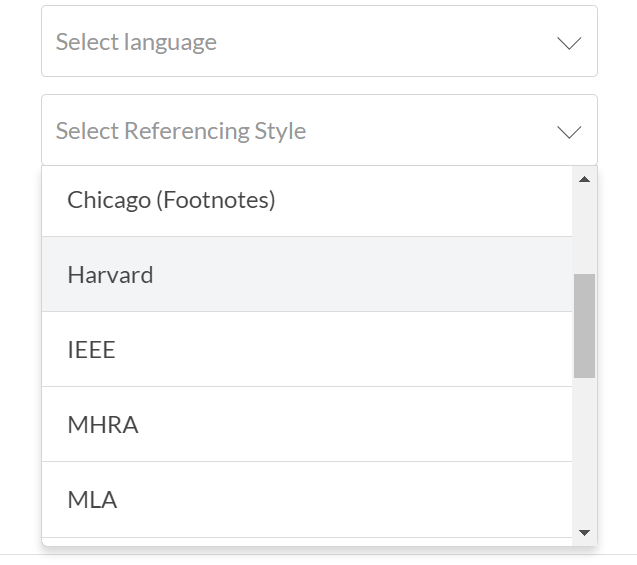Introducing MLA Referencing
The MLA Handbook is published by the Modern Language Association. ‘MLA referencing’, meanwhile, is the citation system set out within this style guide. It is used by many universities and academic journals, particularly within the human sciences. So if you’re using MLA referencing in your work, you’ll want a proofreader who knows this system inside out. That’s where we come in.
MLA Proofreading Services
If you are asked to use MLA referencing in your work, make sure to have it proofread by an expert. Our academic proofreading specialists have in-depth knowledge of the MLA referencing style, so just let us know how we can help.
How To Select
MLA Referencing
When you upload a document to our site, you will be asked to ‘Brief your editor’. Part of this involves selecting a referencing style. So if you’ve used MLA citations in your work, simply select ‘MLA’ from the dropdown menu while uploading your document.
We use the most recent version of MLA referencing as a default (i.e. the version set out in the 8th edition of the MLA Handbook). But if you would like us to use an older version, or if you have further instructions for your editor, let us know via the comment box.

Instant Quote
In-Text Citations In MLA Referencing
MLA is a parenthetical citation system (i.e. you cite sources in brackets). But while most similar systems use an ‘author–date’ format, MLA does away with the ‘date’ bit. As such, all you need to cite is the author’s surname and a page number:
Esperanto was created in the nineteenth century (Zamenhof 48).
The citation above, for example, points to page 48 of a source by ‘Zamenhof’. The reader would then look for ‘Zamenhof’ in the Works Cited list (see below) to find the source in question.
The main variation on this comes when you cite more than one source by the same author, in which case you cite the title instead. Take the following passage, for instance:
Zamenhof writes that Esperanto was created in the late nineteenth century (‘The Origins of Esperanto’ 48). He further explains that it was inspired by the desire to create a ‘lingvo internacia, or international language’ (A Global Language 212).
Here, we’ve cited an article called ‘The Origins of Esperanto’ and a book called A Global Language, both written by Zamenhof. So to ensure the reader always knows which source is being cited, we have used the source titles in the citations.
Works Cited In MLA
If you’re using MLA, you will need a ‘Works Cited’ page. This is where you provide full information on every source you cite. The standard rules for a Works Cited page are:
- Start the list on a new page titled ‘Works Cited’.
- List all cited sources alphabetically by author surname.
- Capitalise each main word in titles of journal articles and books, but not conjunctions, prepositions, or articles unless they are the first word of a title or subtitle.
- Use italics for titles of longer works (e.g. books, journals).
- Place titles of shorter works (e.g. articles, book chapters) in quote marks.
- Use a half-inch (1.27cm) hanging indent for each line after the first in all entries.
Each entry should help readers to find the source in question. The exact format, however, will depend on the source type. A book, for example, would be formatted like this:
Zamenhof, Ludwik. A Global Language. Cambridge University Press, 1917.
Here, we have the author, the title, the publisher, and a year of publication. This ensures the reader will be able to identify the source we have cited. For guidelines on other source types in MLA, see our blog. You can also find useful information on the MLA Style Center website.
Referencing Styles And Systems
Our expert editors can work with a range of referencing styles, including:
We can work with other referencing styles on request, too. Just let us know which system you’re using when you upload your work, and we’ll tailor our service accordingly. For more information on legal referencing styles, such as OSCOLA and AGLC, see our dedicated legal referencing page.




